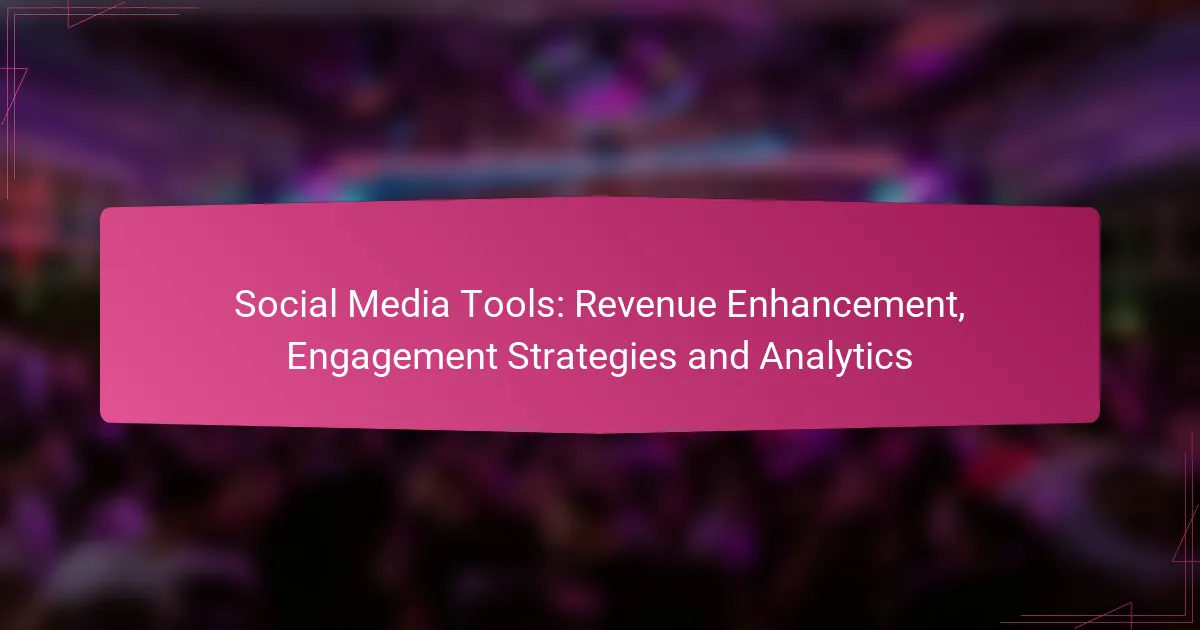Social media tools play a crucial role in enhancing revenue by allowing businesses to effectively target audiences and streamline their sales processes. By employing effective engagement strategies and utilizing analytics, companies can boost customer interaction and gain valuable insights to refine their marketing efforts, ultimately leading to increased profitability.

How can social media tools enhance revenue?
Social media tools can significantly enhance revenue by enabling businesses to reach targeted audiences, streamline sales processes, and promote products effectively. By leveraging these tools, companies can optimize their marketing strategies and improve customer engagement, leading to increased sales and profitability.
Increased ad targeting with Facebook Ads
Facebook Ads allows businesses to target specific demographics, interests, and behaviors, making it easier to reach potential customers. By utilizing detailed audience insights, companies can create tailored advertisements that resonate with their target market, increasing the likelihood of conversions.
To maximize effectiveness, businesses should regularly analyze ad performance and adjust targeting parameters based on engagement metrics. Testing different ad formats and messages can also help identify what works best for their audience.
Sales tracking with Shopify integrations
Integrating Shopify with social media platforms enables businesses to track sales directly from their social channels. This integration allows for seamless transitions from social engagement to purchase, providing valuable data on customer behavior and preferences.
Businesses should ensure that their Shopify store is linked to their social media accounts and utilize analytics tools to monitor sales trends. Regularly reviewing this data can help identify successful campaigns and areas for improvement.
Upselling through Instagram Shopping
Instagram Shopping provides a unique opportunity for businesses to showcase products directly within their posts and stories, facilitating upselling. By tagging products in engaging content, companies can encourage customers to explore additional items that complement their purchases.
To effectively use Instagram Shopping, businesses should focus on high-quality visuals and compelling descriptions. Engaging with followers through comments and direct messages can also enhance customer relationships and drive additional sales.

What engagement strategies can be implemented?
Effective engagement strategies are essential for enhancing audience interaction and driving revenue on social media platforms. Implementing a mix of content scheduling, interactive features, and live streaming can significantly boost user engagement and brand visibility.
Content scheduling with Hootsuite
Content scheduling with Hootsuite allows businesses to plan and automate their social media posts across multiple platforms. This ensures consistent posting and helps maintain audience engagement without the need for constant manual updates.
To maximize effectiveness, analyze peak engagement times for your target audience and schedule posts accordingly. Aim for a mix of promotional and value-driven content to keep followers interested.
Common pitfalls include over-scheduling, which can lead to audience fatigue, and neglecting real-time engagement. Regularly review analytics to adjust your strategy based on performance metrics.
Interactive polls on Twitter
Interactive polls on Twitter are a straightforward way to engage your audience and gather valuable feedback. These polls can be used to gauge opinions, preferences, or even to spark discussions around your brand.
To create effective polls, keep questions clear and concise, and limit options to a few choices to encourage participation. Engaging with users who respond can further enhance community interaction.
Avoid overly complex questions that may confuse followers. Instead, focus on topics that resonate with your audience to drive higher engagement rates.
Live streaming on TikTok
Live streaming on TikTok offers a dynamic way to connect with your audience in real-time. This format allows for immediate interaction through comments and questions, creating a more personal connection with viewers.
When planning a live stream, promote it in advance to build anticipation and encourage attendance. Consider themes that align with your brand and invite audience participation through Q&A sessions or giveaways.
Be mindful of technical aspects, such as lighting and sound quality, to ensure a professional presentation. Regularly analyze viewer engagement during streams to refine future content and improve interaction rates.

How do analytics improve social media performance?
Analytics enhance social media performance by providing data-driven insights that inform strategy and decision-making. By analyzing user behavior, engagement levels, and conversion rates, businesses can optimize their content and campaigns for better results.
Insights from Google Analytics
Google Analytics offers valuable insights into website traffic generated from social media platforms. By tracking metrics such as user demographics, session duration, and bounce rates, businesses can identify which social channels drive the most engaged visitors.
To maximize the effectiveness of Google Analytics, set up goals that align with your social media objectives. For instance, if your aim is to increase newsletter sign-ups, track conversions from social media referrals to measure success.
Engagement metrics with Sprout Social
Sprout Social provides robust engagement metrics that help businesses understand how audiences interact with their content. Key metrics include likes, shares, comments, and overall engagement rates, which can reveal what types of posts resonate most with followers.
Utilize Sprout Social’s reporting features to analyze engagement trends over time. This can help identify peak posting times and content themes that drive higher interaction, allowing for more targeted content strategies.
Conversion tracking via HubSpot
HubSpot enables businesses to track conversions directly from social media campaigns, linking social interactions to sales outcomes. By setting up tracking URLs and monitoring conversion rates, companies can assess the ROI of their social media efforts.
To effectively use HubSpot for conversion tracking, ensure that your social media posts include clear calls-to-action (CTAs) that guide users toward desired actions, such as making a purchase or signing up for a webinar. Regularly review conversion data to refine your approach and improve results.

What criteria should be considered when choosing social media tools?
When selecting social media tools, consider factors such as budget, integration with existing systems, user-friendliness, and the specific features that align with your business objectives. Prioritizing these criteria helps ensure that the tools effectively enhance engagement and drive revenue.
Budget constraints for small businesses
Small businesses often operate with limited budgets, making it essential to choose social media tools that offer good value. Look for platforms that provide tiered pricing plans, allowing you to start with basic features and upgrade as your needs grow. Free trials can also help assess a tool’s effectiveness before committing financially.
Consider tools that offer essential features without overwhelming costs. For example, platforms like Hootsuite or Buffer provide affordable plans for scheduling posts and analyzing engagement, which can fit within a modest budget.
Integration capabilities with existing platforms
Choosing social media tools that integrate seamlessly with your current systems is crucial for maximizing efficiency. Look for tools that connect with your customer relationship management (CRM) software, email marketing platforms, and analytics tools. This integration allows for streamlined workflows and better data analysis.
For instance, tools like Zapier can facilitate connections between various applications, enabling automated processes that save time. Ensure that the tools you select support the platforms you already use to avoid disruptions and enhance overall productivity.

What are the emerging trends in social media tools?
Emerging trends in social media tools focus on enhancing user engagement and optimizing revenue through innovative technologies. Key developments include AI-driven content creation, augmented reality in advertising, and evolving data privacy regulations that shape analytics practices.
AI-driven content creation tools
AI-driven content creation tools automate the generation of social media posts, graphics, and videos, allowing brands to produce high-quality content efficiently. These tools analyze audience preferences and trends to create tailored messages that resonate with users.
Popular platforms like Canva and Lumen5 leverage AI to simplify design and video editing, making it accessible for businesses of all sizes. Consider using these tools to maintain a consistent posting schedule and enhance audience engagement.
Augmented reality features in advertising
Augmented reality (AR) features in advertising allow brands to create immersive experiences that engage users in unique ways. By integrating AR into social media campaigns, companies can showcase products in a more interactive manner, encouraging users to visualize items in their own environment.
For example, beauty brands often use AR to let customers try on makeup virtually through apps like Instagram and Snapchat. This approach not only boosts engagement but also increases conversion rates by providing a more personalized shopping experience.
Data privacy regulations impacting analytics
Data privacy regulations, such as the General Data Protection Regulation (GDPR) in Europe and the California Consumer Privacy Act (CCPA) in the U.S., significantly impact how social media analytics are conducted. These laws require businesses to prioritize user consent and transparency when collecting and analyzing data.
As a result, marketers must adapt their strategies to comply with these regulations while still gathering valuable insights. This may involve using aggregated data or anonymizing user information to ensure compliance without sacrificing analytical depth.

How can businesses leverage social media for future growth?
Businesses can leverage social media for future growth by enhancing brand visibility, engaging with customers, and utilizing analytics to inform strategies. By effectively using social media tools, companies can build relationships, drive sales, and adapt to market trends.
Building brand loyalty through community engagement
Community engagement on social media fosters brand loyalty by creating a sense of belonging among customers. Businesses can achieve this by actively participating in conversations, responding to comments, and hosting events or live sessions that encourage interaction.
To strengthen community ties, consider creating exclusive groups or forums where customers can share experiences and feedback. This not only enhances loyalty but also provides valuable insights into customer preferences.
Utilizing user-generated content for authenticity
User-generated content (UGC) is a powerful tool for establishing authenticity and trust. By encouraging customers to share their experiences with your products or services, businesses can showcase real-life applications and testimonials.
Incorporate UGC into marketing campaigns by featuring customer photos or reviews on social media and your website. This approach not only enriches your content but also makes customers feel valued and recognized.
Adapting to changing consumer behaviors
To stay relevant, businesses must adapt to evolving consumer behaviors, which can shift rapidly due to trends or external factors. Monitoring social media analytics helps identify these changes, allowing companies to adjust their strategies accordingly.
Regularly review engagement metrics and audience feedback to understand what resonates with your customers. This proactive approach enables businesses to refine their content, optimize posting schedules, and tailor offerings to meet current demands.
